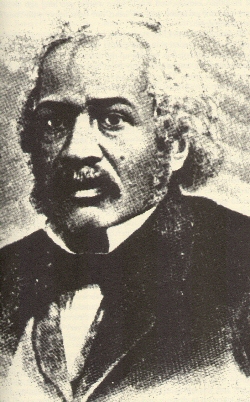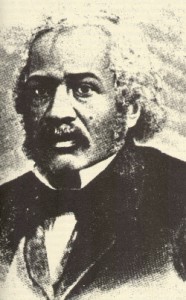
Continuing with this week’s theme, I am going to highlight some more historic African-American firsts. Today’s person had a very interesting life and sadly, he is still not discussed very much. He is also one of the earliest advocates of the use of “black” instead of “colored.”
James McCune Smith (April 18, 1813 – November 17, 1865) was an American physician, apothecary, abolitionist, and author. He is the first African American to hold a medical degree and graduated at the top in his class at the University of Glasgow, Scotland. He was the first African American to run a pharmacy in the United States.
In addition to practicing as a doctor for nearly 20 years at the Colored Orphan Asylum in Manhattan, Smith was a public intellectual: he contributed articles to medical journals, participated in learned societies, and wrote numerous essays and articles drawing from his medical and statistical training. He used his training in medicine and statistics to refute common misconceptions about race, intelligence, medicine, and society in general. Invited as a founding member of the New York Statistics Society in 1852, which promoted a new science, he was elected as a member in 1854 of the recently founded American Geographic Society. But, he was never admitted to the American Medical Association or local medical associations.
He has been most well known for his leadership as an abolitionist; a member of the American Anti-Slavery Society, with Frederick Douglass he helped start the National Council of Colored People in 1853, the first permanent national organization for blacks. Douglass said that Smith was “the single most important influence on his life.” Smith was one of the Committee of Thirteen, who organized in 1850 in New York City to resist the newly passed Fugitive Slave Law by aiding fugitive slaves through the Underground Railroad. Other leading abolitionist activists were among his friends and colleagues. From the 1840’s, he lectured on race and abolitionism and wrote numerous articles to refute racist ideas about black capacities.
Both Smith and his wife were of mixed-race African and European ancestry. As he became economically successful, he built a house in a good neighborhood; in the 1860 census he and his family were classified in that neighborhood as white, whereas in 1850 they were classified as mulatto. He served for nearly 20 years as the doctor at the Colored Orphan Asylum in New York but, after it was burned down in July 1863 by a mob in theNew York Draft Riots, in which nearly 100 blacks died, Smith moved his family and practice out to Brooklyn for safety. The parents stressed education for their children. In the 1870 census, his widow and children continued to be classified as white. To escape racial discrimination, his children passed into white society: the four surviving sons married white spouses; his unmarried daughter lived with a brother. They worked as teachers, a lawyer, and business people.
Smith’s unique achievements as a pioneering African-American doctor were rediscovered by twentieth-century historians. They were relearned by his descendants in the twenty-first century when a three-times-great-granddaughter took a history class and found his name in her grandmother’s family bible. In 2010, several Smith descendants commissioned a new tombstone for his grave in Brooklyn. They gathered to honor him and their African-American ancestry.
Smith was born free in 1813 in New York City (New York state had passed gradual abolition in 1799; children of slave mothers were born free but had to serve an indenture until early adulthood.) His mother, believed to be Lavinia Smith, achieved her freedom later in life; she said she was a “self-emancipated woman.” She was born into slavery in South Carolina and had been brought to New York as a slave. His father was Samuel Smith, a white merchant and his mother’s master, who had brought her with him to New York from South Carolina.
The boy grew up only with his mother. As an adult, James Smith alluded to other white ancestry through his mother’s family, saying he had kin in the South, some of whom were slaveholders and others slaves.
Smith attended the African Free School (AFS) #2 on Mulberry Street in Manhattan, where he was described as an “exceptionally bright student”. He was among numerous boys who went on to have brilliant careers, some of whom he worked with in the abolitionist cause. In the course of his studies, Smith was tutored by Rev. Peter Williams, Jr., a graduate of the African Free School who had been ordained in 1826 as the second African-American priest in the Episcopal Church. {Williams had founded St. Philip’s African Church in New York City.} Upon graduation, Smith applied to Columbia University and Geneva Medical College in New York State, but was denied admission due to racial discrimination.
Williams encouraged Smith to attend the University of Glasgow in Scotland. He and abolitionist benefactors of the AFS provided Smith with money for his trip overseas and his education. Through abolitionist connections, he was welcomed there by members of the London Agency Anti-Slavery Society. According to the historian Thomas M. Morgan, Smith enjoyed the relative racial tolerance in Scotland and England, which officially abolished slavery in 1833. New York had finally abolished all slavery in 1826. He studied and graduated at the top of his class. He obtained a bachelor’s degree in 1835, a master’s degree in 1836, and a medical degree in 1837. He also completed an internship in Paris.
After his return to New York and getting established, in the early 1840s Smith married Malvina Barnet (c.1825 – ), a free woman of color who was a graduate of the Rutger Female Institute.They had seven children and five survived to adulthood.
In 1850, the senior Smith’s household included four older women: Lavinia Smith, age 67 (his mother: b. c.1783 – d. bet.1860-1870), born in South Carolina and listed first as head of household; Sarah Williams, 57; Amelia Jones, 47; and Mary Hewlitt, 53, who were likely relatives or friends. By then Smith and his wife Malvina had three children: James, Henry and Amy. Each member of the household was classified as mulatto (or of mixed ancestry), and all but Lavinia Smith were born in New York. They lived in a mixed neighborhood in the Fifth Ward; in the census, nearly all other neighbors on the page were classified as white; many were immigrants from England, Ireland, and France.

